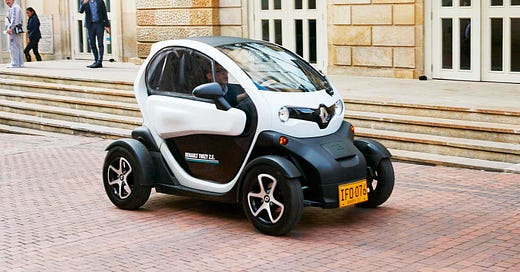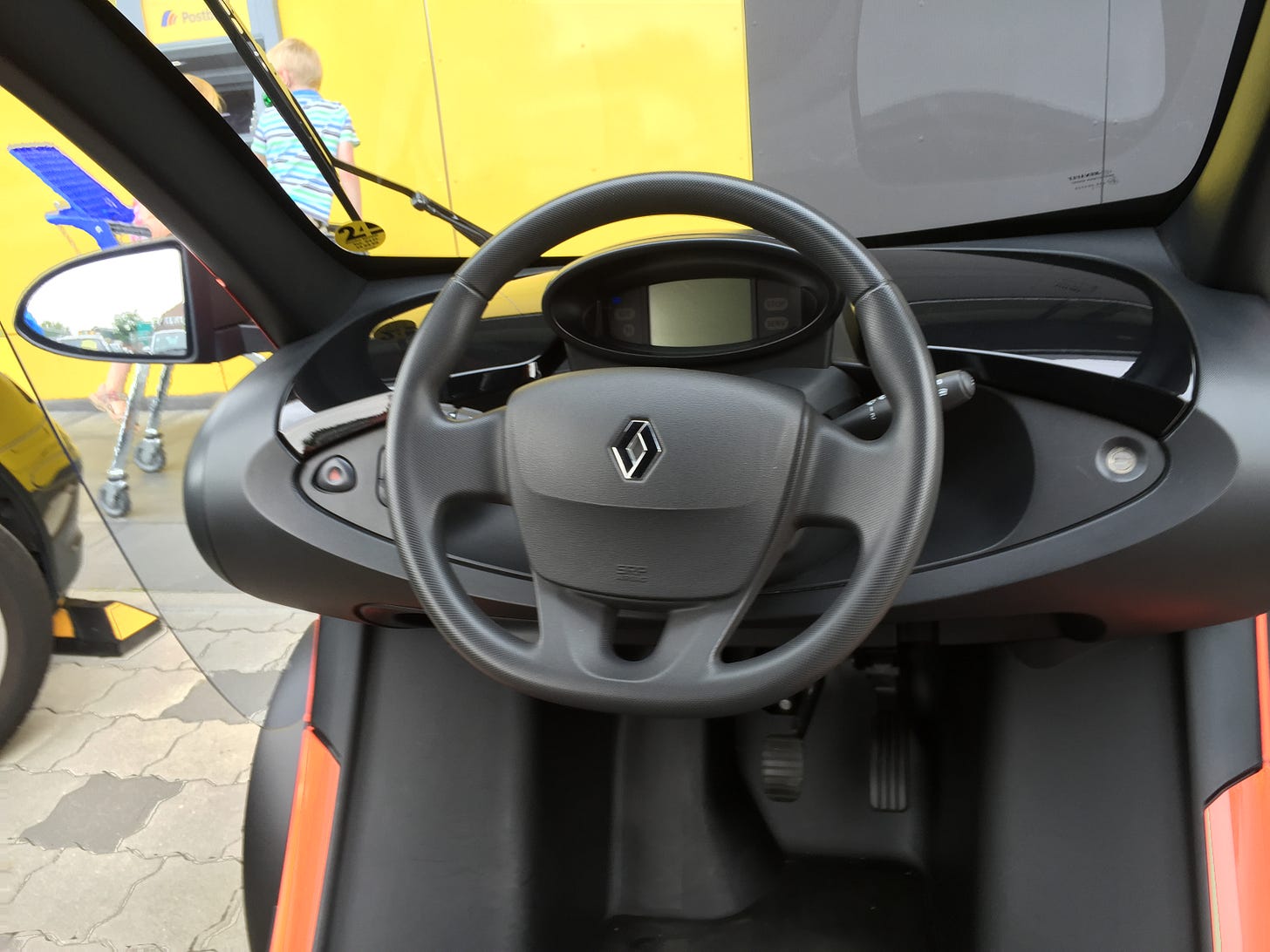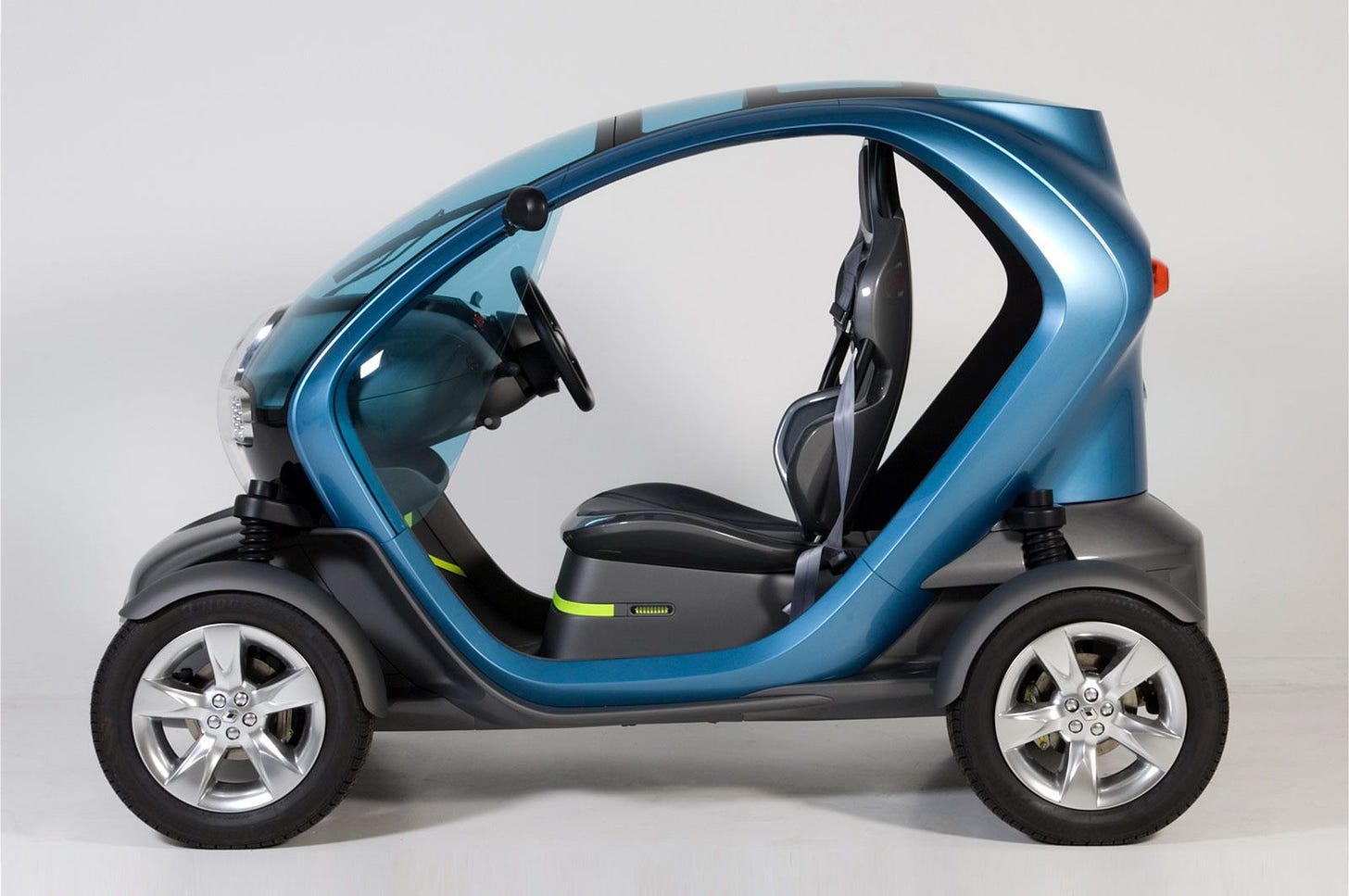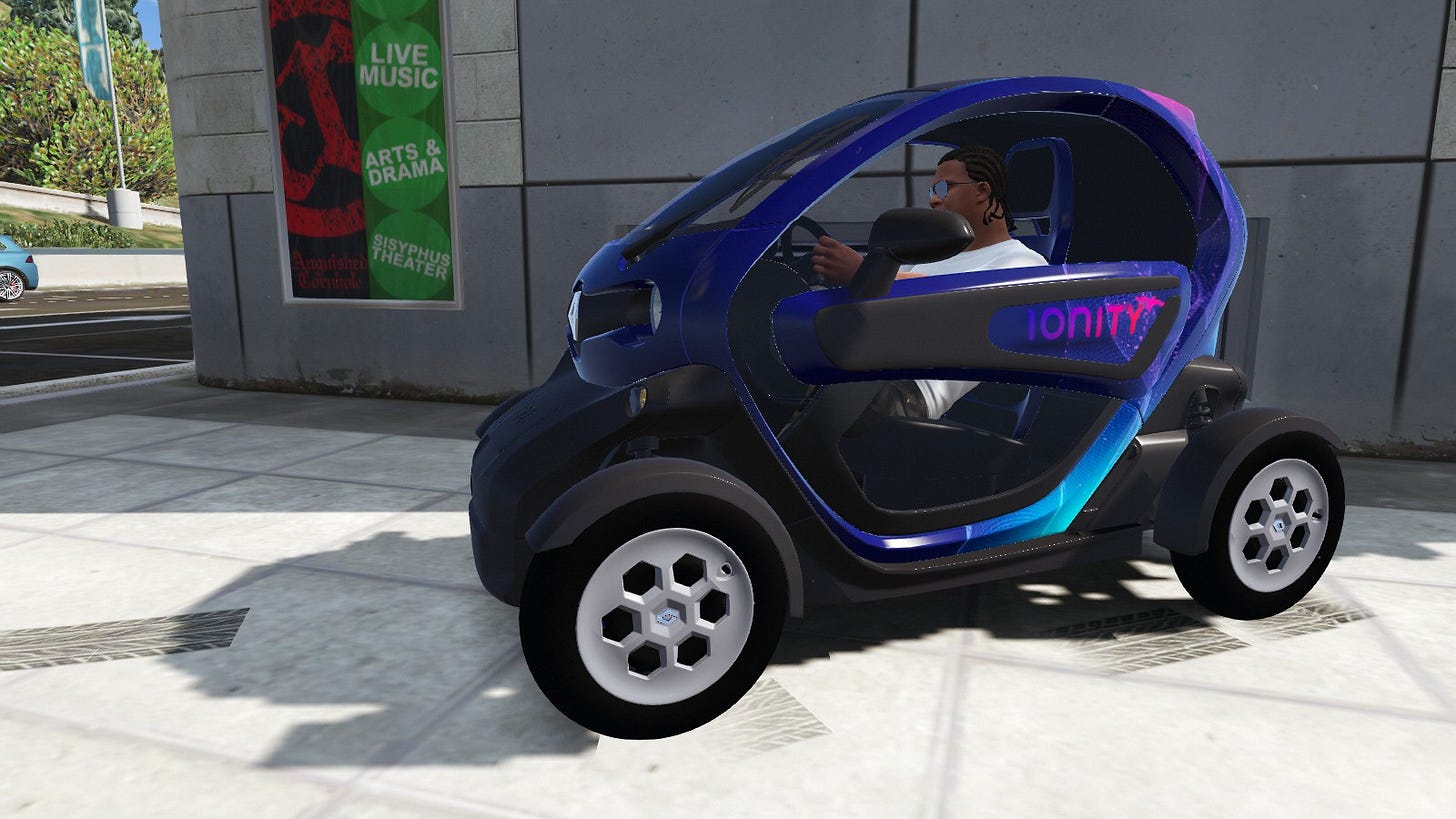Renault Twizy Z.E
Hello, electric car lovers! In this blog, I cover all the latest tech news surrounding electric cars. I cover the background, feel and drive, the current selling price, and the specs and engineering that go into making each car. If you have an electric car that you’d like me to cover let me know in the comments below. In today's article, I’m reviewing the new and upcoming The Renault Twizy Z.E. I’ll be covering the most important features to see whether it stands against the competition or not. Oh, and one more thing before I start -BREAKING NEWS: Apple and Kia Motors have joined forces to produce a kit set electric car in sweden...... they are calling it the iKia
Okkaayyyy... Now back to the article.
Background
Renault Twizy is a two-seat microcar that it created and sells. It is classed as a light or heavy quadricycle in Europe, based on the output power, which is either the 45 model or the 80 model, with both titles reflecting the highest speed in kilometers per hour. Originally produced in Valladolid, Spain, production was relocated to Busan, South Korea, in March 2019 to fulfill rising Asian demand.
Françoise Leboinne and Luciano Bove developed the Twizy, which debuted as a concept car at the 2009 Frankfurt Motor Show. Nissan introduced the New Mobility Concept, or NMC, a rebadged Twizy version in November 2010. Although it was marketed as a Renault in South Korea for production, it was also shown as a concept with Renault Samsung badging at the 2011 Seoul Motor Show. Renault announced the Twizy's production in May 2011 and began collecting reservations.
The Twizy was first introduced on the French market in March 2012, and numerous other European countries followed a month later. The Twizy is available in three variants, but the battery pack must be rented for a monthly charge that includes roadside assistance and a battery replacement warranty.
The Twizy became available for direct purchase in the United Kingdom in 2020. It is no longer necessary to hire a battery.
During 2012, the Twizy was Europe's best-selling plug-in electric vehicle. In April 2015, Twizy reached the 15,000 Twizys sold globally. Through December 2019, global cumulative sales totalled 29,118 units.
The driver and passenger sit in a line rather than next to each other, and the Twizy is propelled along by a tiny 17bhp electric engine that drives the back wheels.
Performance isn't particularly impressive, thus the Twizy is mostly intended as a city commuter. However, you should get about 45 miles between charges (less in cold weather), and it takes three and a half hours to charge the battery from empty using a domestic three-pin plug.
When compared to larger, more sophisticated electric automobiles, does the Twizy make sense? To discover it, keep watching the review.
Design and engineering
The Renault Twizy is an electric quadricycle that serves as a sort of midpoint between a vehicle and a motorcycle in terms of performance. Even though it is on four wheels, it is just 2.3 meters long and 1.4 meters broad, which is possibly the most crucial aspect of its design. However, it is of a comparable height as a Twingo. Only two people can fit inside, the inside is stripped down to its bare essentials, and there are no doors included as usual. But, well, who cares? Just have a look at it. Isn't this the coolest electric vehicle that has ever been introduced or what?
Interior
In reality, the Twizy does not have an interior. According to reviews from car journalists, Even with the optional doors installed – which open in a scissor-like motion, similar to that of a supercar – you'll be exposed to the elements significantly more than you would be in a typical car with all the windows up. Windows are available as a dealer-installed option, however they are akin to the windows of a tent, and as such, they're known for not providing much in the way of noise insulation, but they do keep out the worst of the wind and rain.
The speed, remaining range, and how hard the motor is being worked are all displayed on the instrument panel, which is located behind the steering wheel. However, apart from that, the Twizy's interior is sparse, which is a good thing considering how much of its exterior is exposed to the outdoors. Hard plastics and rubberized water-resistant materials are the rule of the day throughout the whole building structure. The driver's seat may be adjusted only in terms of back and forward movement; there is no height adjustment and the backrest angle is fixed. Aside from that, there isn't much movement on the steering wheel, yet it's said that it isn't difficult to become familiar with.
There is no radio available, but there is a rather rudimentary Bluetooth system that allows you to make and receive calls while on the go, as well as play music from your phone. The combination of poor quality speakers and all of the background noise, on the other hand, might make talking on the phone a difficult proposition.
Performance
Driving the Twizy is obviously a piece of cake. With a normal steering wheel, two pedals (an accelerator and a brake), and only three buttons on the dashboard, the car is simple and uninspiring. Press the button labeled D, then release the handbrake, and you're on your way.
While the Twizy pulls away in relative quiet, I'm told you'll soon hear the characteristic whine of the electric engine as you gain speed as the vehicle accelerates. After a time, this becomes grating, and because there are no doors or windows as normal, you are exposed to the outdoors as well as the general commotion of other vehicles, which may be uncomfortable. Ps: Expect to have to yell in order to communicate with the passenger in front of you, according to test reviews.
Astonishingly tiny turning circle of 6.8 meters; this is less than that of a Smart Fortwo, itself a king of urban mobility. The brakes are progressive, and the steering is described "precise and astonishingly well weighted." The Twizy's stopping ability isn't very outstanding, owing primarily to the vehicle's thin tyres and the lack of anti-lock brakes to prevent the vehicle from locking up completely.
As a result of the Twizy's weight being less than half that of a Ford Fiesta, its performance is not as terrible as you might expect. Sure, the top speed is just 50mph and it takes a while to get there, but the acceleration away from the lights is decent, with Renault claiming a time of 6.1 seconds from 0 to 28 miles per hour (mph). Simply said, the car's performance is acceptable for commuting inside cities and towns, and even short A-road excursions aren't out of the realm of possibility. I would not recommend driving on the freeway, despite the fact that some Twizy owners do.
The ride, on the other hand, is said to be far less spectacular; it is way too stiff at any speed and is particularly uncomfortable over potholes and speed bumps in metropolitan areas. As a point of comparison, the Twizy is far less comfortable than any standard road car you've ever driven.
Battery Life
Renault sells batteries on a monthly basis, with variable periods and yearly mileages, similar to a cell phone contract. This lowers the Twizy's initial purchase price and is the key to its overall affordability. The battery has a range of about 60 miles, and Renault includes a three-meter spiral line so you can charge it anywhere.
The lithium-ion battery with a capacity of 6.1 kWh is housed beneath the front seat. The weight of both motor versions is the same (1,045 lb), including batteries (220 lb). The range is homologated at 62 miles, as I previously said. Renault claims a range of 50 miles in real-world situations. The Twizy's range is around 31 miles at high speeds with no eco-driving.
An extensible spiral cable kept behind a flap at the front of the vehicle may be used to charge the battery. The inbuilt charger works with both roadside battery charging stations and a typical residential electrical supply of 220-240 V 10 A. It takes around three and a half hours to charge an empty battery.
Due to technical issues, a proposed Renault battery facility near Paris has been postponed. Construction will commence in the second quarter of 2012[needs update], with battery manufacturing beginning in 2014 or 2015. [needs to be updated] Renault will obtain batteries for its electric vehicles from a joint venture between Nissan Motor and NEC, as well as LG Chem of South Korea, in the meanwhile.
LG Chem modules are the only ones Twizy comes with. The Renault Valladolid facility assembles the batteries.
Price and Model Range
The Twizy is far less expensive than 'real' electric vehicles like the Renault Zoe and Nissan Leaf. The asking price is very appealing, albeit you must figure in an additional monthly charge to lease the battery pack from Renault - there is no option to buy it outright in some places like the UK, for example.
Running expenses will be minimal as well, because there will be no road tax and the impact on your power bills will be significantly less than what you'd spend to fuel a typical gasoline or diesel automobile. However, insurance rates aren't as low as you may think, because of Twizy's dismal two-star Euro NCAP safety rating.
The standard equipment is rudimentary. You won't even have doors if you don't have air conditioning. You do, however, receive a driver's airbag and alloy wheels if you choose the Dynamique trim level. There are a variety of quirky color combinations to pick from, and for a price, Renault can even wrap your Twizy in a Union Jack or leopard pattern.
Scissor doors, a rudimentary Bluetooth system, an anti-lift alarm, and a transparent roof are all available as options, with plastic windows available as a dealer-fit extra.
Unfortunately, the Twizy can only be charged with a three-pin household outlet, which means it won't work at many electric vehicle charging stations. Symphony EV, on the other hand, supplies an ingenious adaptor that solves this difficulty.
Pricing and Infographics
Available as a full purchase or with battery rental, the Renault Twizy starts at around $9,540 including tax (license-free version limited to 45 km / h) in its version with battery rental. A price to which you will have to add a rent starting from $ 50 incl. Tax / month which will depend on the duration of the contract and the distance traveled. The Twizy 80 version (car license required) is displayed from around $10,240 including VAT, excluding battery rental.
In terms of finishes, two levels are available:
● Twizy Life which is the basic version, available in 4 colors: Caribbean blue, filament red, star black and snow white. This trim costs $12,700
● Twizy Intens which receives several additional aesthetic elements: carbon decoration on the roof and the glove box lids, diamond-coated aluminum rims ... This trim costs $13,500
This wraps up my review of The Renault Twizy Z.E, let me know what you think of it. Thank you for sticking it out through to the very end of this article! Nothing helps out my blog more than y’all reading the entire article. These articles take a long time to make and are a labor of love. If you would like to see my blog grow, please help spread the word and until next time, remember, the best experiences aren’t about where you end up, but who you’re lucky enough to be on the journey with.






